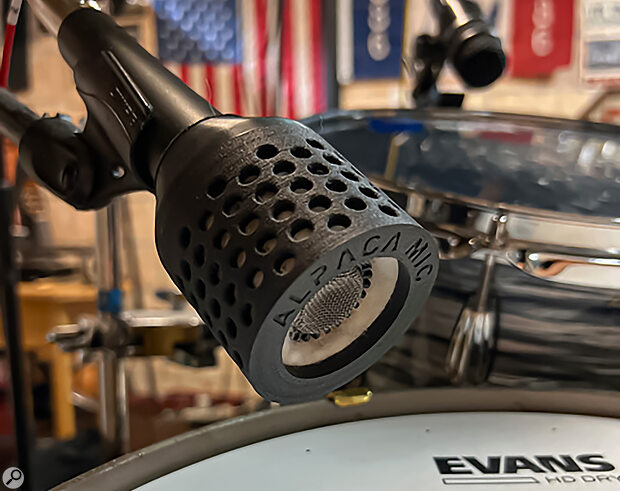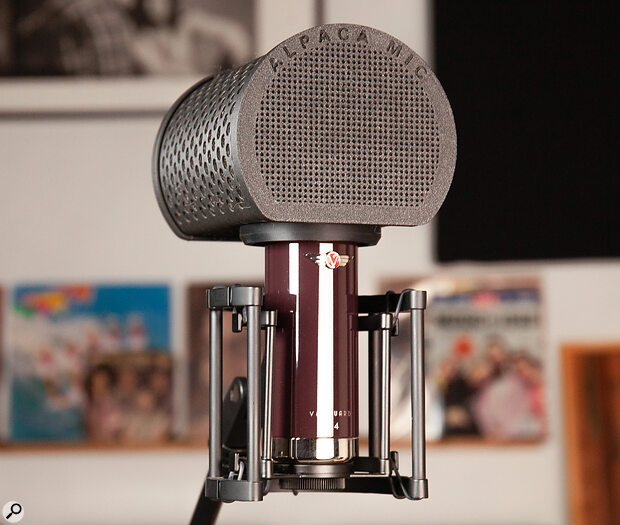Made using real alpaca wool, this quirky microphone filter aims to solve a number of recording problems.
Many core products and practices in recording studios have remained constant for several decades. Microphones, for example, have broadly followed the same design principles for almost a century, as have microphone accessories like pop filters and stands. As a result of this, when someone brings to the table a new product that challenges established ways of working with micophones, it can be easy to quickly dismiss it.
The Alpaca Mic is a 3D‑printed device that is intended to sit on top of and surround the headbasket of your microphone. One end of the unit is designed to perform like a typical pop filter, while the inside of the housing is lined with alpaca fibre. Alpaca Mic’s website lists a number of benefits to using this natural product (yes, it’s from real alpacas!), including the fact it doesn’t retain any moisture, is naturally anti‑static and allows air to freely pass through.
Why would we want to surround our microphone with it, though? The designers suggest that this material can filter and soften off‑axis sounds coming into a (cardioid) mic, which can help reduce unpleasant reflections when recording in an untreated space. This has the potential to be a useful tool for people trying to get good recordings in a home setting, and could also be a way of adapting the sound of a microphone to suit a particular source. Sensibly, Alpaca do not claim that it will reduce the capture of unwanted noise.
We actually have two products to look at in this review: the original Alpaca Mic, and its smaller sibling, the Alpaca 57, which is intended to work with a Shure SM57 dynamic mic. If you’re tempted to give the larger Alpaca Mic a try, you need to ensure you have the right ring adaptor for your mic. Several rings are available, and between them, should cover most small to medium‑sized side‑address mics. I fed back to the designers that this is an aspect of the product that needs a little refinement, though: swapping the rings out often felt too tight, and with expensive mics (with delicate switches) you don’t want to be squeezing them into place too hard.
 The Alpaca 57 is designed to fit on Shure’s classic SM57.
The Alpaca 57 is designed to fit on Shure’s classic SM57.
Does It Work?
The short answer to this all‑important question is: yes and no. I tried the Alpaca Mic on a few different capacitor mics during the review period, and if you’re interested in hearing for yourself, I’ve provided a few audio examples to accompany this review. The thing I liked the most was how the it could tame the high‑frequency response of a mic, to reduce excessive sibilance on vocals or to soften the cymbals on a room or character mic on a drum kit. This comes with a little compromise, however, as it often affected the lower midrange, occasionally introducing unpleasant boxiness around 400Hz. I also wasn’t 100 percent convinced by the designers’ claim that it can improve isolation for a mic in an untreated acoustic space. I tried the Alpaca Mic in a few different spaces in my studio, including a completely untreated corridor, and while I could hear a small reduction in room reflections/tone, it wasn’t night and day by any means. Considering some of the potential side‑effects of surrounding your mic with a product like this, careful testing would be needed to make sure it was a worthwhile trade‑off in your recording space.
With the Alpaca 57, the advantages were clear cut: it did help reduce the often harsh high‑end spill from the hi‑hat, but crucially retained that midrange ‘bark’ that is such a part of the SM57’s appeal...
Hats Off
Engineers who regularly record live drums, especially for heavy genres of music, will be well aware of the common issue of hi‑hat spill getting into your close snare mic. At the recording stage it can often not seem too bad, but once you start to add high‑frequency EQ to your snare channel when mixing, you can quickly be presented with ear‑scratching hi‑hats that prove tricky to gate or minimise without choking the sound of the snare drum. In my tests with the Alpaca 57, the advantages were clear‑cut: it did help reduce the often harsh high‑end spill from the hi‑hat, but crucially retained that midrange ‘bark’ that is such a part of the SM57’s appeal as a snare mic. Also, engineers are much more comfortable getting heavy‑handed with EQ in this kind of application, so concerns about changing the natural response of your mic are perhaps less than with a capacitor mic for vocals.
 Here you can see the inside of the Alpaca Mic, with the alpaca fibres exposed.
Here you can see the inside of the Alpaca Mic, with the alpaca fibres exposed.
Summing Up
The larger Alpaca Mic is one of the best‑sounding products of this kind that I have auditioned, but there’s no escaping the fact that putting a bulky object around a microphone basket is going to change how that mic performs. The result of this is a trade‑off. You can get a small but noticeable reduction in high‑frequency room sound entering your mic when recording in an untreated space, but you will probably find yourself reaching for an EQ to cut the low mids. My favourite use, however, was as a creative device for softening the response or changing the personality of a brighter microphone. I would suggest that this is a product that has potential, but requires a little refining to be a clear‑cut option for a home recordist — especially the mounting system. However, I can be more positive about the Alpaca 57, having used it on a few different drum recording sessions. Any tool that I can quickly pull out for drummers who bash their hi‑hats is very welcome!
Summary
The Alpaca Mic and Alpaca 57 offer unusual solutions to common recording problems, with the help of some 3D printing and the natural qualities of alpaca fibre.

